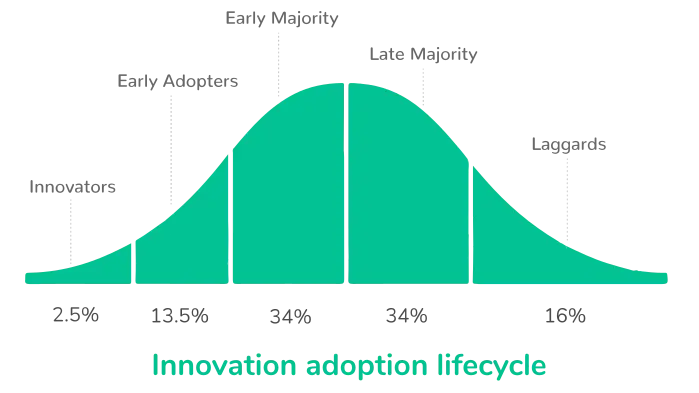In this guide, we’ll define product adoption, learn a little about the product adoption curve, and give you five steps to building a product adoption strategy that works. Let’s get started.
What is product adoption?
Product adoption, also known as user adoption, refers to the “aha moment” when users see the value of your product or feature and decide to become active users. When you launch a new product or feature, there are five stages of the product adoption curve – a model that illustrates how and when different users adopt your product.
Why is Product Adoption Important?
Product adoption is the process of educating prospective buyers, new users, and current consumers about your product and its benefits. A good product adoption process is one that persuades people to move from merely trying your product to using it regularly, and then adopting it as the solution and persistently extracting maximum value out of it.
Adopting a product is the first step in accomplishing almost any objective in business. Goals include lowering customer attrition, boosting customer loyalty, sales, and profits, and fostering a positive brand image. Your ability to persuade people to adopt your product depends on their discovering its huge worth.
Take a look at these vital measurements that will provide light on what aspects affect adoption success.
Time-to-Value (TTV)
Once a customer makes a purchase or registers for a free trial, the timer will begin counting down. You have a little window of opportunity to prove your worth before they abandon ship. We all despise having to invest a lot of time and energy into getting used to a new product. Our only concern is how soon customers can start enjoying the benefits of the product. And the time to make that case is really short! However, things shift once the customer sees the value in your offering. The turnover rate declines as quickly as this occurs.
Product Activation Rate
Activation is the point at which a consumer experiences the value promised by your product for the first time. Before taking any measurements, you should mark a completion-related event or milestone on your app. One kind of activation could be the simple act of a user downloading and installing your application.
Feature Adoption
The percentage of users who have adopted new use cases and are making full use of your product’s latest features is a strong indicator of their commitment to your product as a whole.
Product Qualified Leads
Users who have completed the required steps within your product to activate it are ready for the next phase. In general, they are the customers who have recognized the value your product provides and are prepared to take it to the next level.
Customer Lifetime Value (CLV)
Customer retention rates will rise as product usage rises, leading to a higher lifetime value. The latter is a measure of how much money a customer is worth over their whole lifetime. When customer lifetime value (CLV) is high, consumers tend to stick around for a longer period of time.
Product Adoption Framework
The product adoption curve provides a high-level overview of product uptake. Varying client groups acquire a product at different rates at various points throughout its lifecycle, as depicted by the curve.

Innovators
Only 2.5% of potential customers are innovators, yet they’re the ones who get the most out of cutting-edge tech and are therefore the most likely to purchase your product. They are valuable in providing early feedback because they don’t care if your product isn’t perfect. Although innovators take great delight in being among the first to try something new, they typically don’t remain around for very long. They have the technical knowledge and value the opportunity to speak with your product team directly.
Early Adopters
In terms of adopting new technologies, Early Adopters are second only to Innovators. Due to the influence of user ratings, early adopters are less patient with software flaws and more interested in getting a solution that meets their needs. They have the means to invest heavily in your offerings and take great satisfaction in being early adopters of innovative items.
Providing first-rate customer service is crucial if you want to win over the Early Adopters and convince them they made the right choice.
Early Majority
The Early Majority is a sizable demographic, making them an essential customer base to target. They are quite risk-averse and will only use a tried-and-true product. They’ll be swayed to follow suit if the actions of Innovators and Early Adopters suggest the solution is worthwhile. If you can convince the Early Majority that your product is worth their time, you may have found one of your most devoted consumer bases.
Late Majority
Similar to the Early Majority, the Late Majority is a sizable customer base. However, the name implies that they are sluggish to adopt new technologies, and they will not tolerate any technical flaws in the product. You’ll need a lot of references from happy customers to persuade them that your product is worth the investment.
Laggards
People who are slow to adapt to changing circumstances are also slow to try anything new. However, they are the second largest client sector your company should target, accounting for 16% of the product adoption curve. The majority of the time, they wait until they have no choice but to accept a new technology long after it has been introduced.
What is a product adoption strategy?
Product adoption strategies are strategies to make your users aware of your product and its value and drive them to use it in various customer journey stages. Product adoption strategies generally answer the question, “What,” “Why”, and “How”.
- What are your goals?
- Why are you pursuing these goals?
- How do you achieve these goals, and how would you measure success?
By having a product adoption strategy in place, your team will better understand what needs to be done, why, and how to achieve success.
But how do you create an effective product adoption strategy?
Here are five steps to making an effective product adoption strategy:
Product adoption as an objective
The first step in a product adoption strategy is to make product adoption the north star of your objective. Make it clear that you are all in this together as a team.
Remember, product adoption happens at various points in the customer journey – from awareness to adoption to retention. So it is not something that a single team is responsible for achieving.
For instance, the marketing team is responsible for driving awareness, educating customers, and promoting the business. The sales team can take a shot at converting a new business opportunity into a deal and building it into a long-term relationship through upselling and cross-selling. The customer success team ensures that the users get the maximum value out of your product.
The key to making this work is setting expectations clearly, and communicating that throughout the team. Make sure everyone knows what they’re doing and why they’re doing it. And be sure everyone understands how their contributions will make a difference for everyone else on the team.
Define the Customer Journey
Now that you’ve made product adoption your “north star” objective, the next step is to understand and map out the customer journey.
The customer journey is a series of steps a potential customer takes to become familiar with your products, services, and brand. It helps you understand what stage in the buying process your target audience is at and how you can make them aware of your offerings.

Remember, the customer journey is not a one-size-fits-all thing. They might vary based on your particular product or service, but here’s an example of what the customer journey typically includes:
- The awareness phase Awareness is the first stage in the customer journey. The awareness phase is where the user gets introduced to the idea of your brand. The user has become familiar with the name and logo and has learned about your products or services.
- The awareness phase is an opportunity to educate users on what you do and how you help them.
- The activation phase The activation phase is where you get your users to try out your product with a demo, free trial, or something similar. It’s essential to keep the user engaged and interested in the process. You can do this by offering them a free trial before they have to make any purchases or commitments.
- The activation phase is also an opportunity to gather valuable feedback from your users. You can use this information to improve your product and make it even better than before.
- The adoption phase Users enter the adoption stage when they reach their aha moment and realize the value a product brings to them. At this stage, your product is still not a part of their daily workflow, so they can still churn.
- In this stage, you need to find ways to encourage users to use your product often.
- The retention phase During this phase, your users use your product frequently, enjoy it, and want to renew their subscriptions.
Understand your current customer experience
A crucial step in building a product adoption strategy is understanding and improving your current customer experience. The goal of this exercise is to identify gaps in the current product and service offering that can create a stronger value proposition for your customers.
You need to understand what drives product adoption and retention and what makes customers churn. A lot of this data comes from customer feedback surveys and online forums, but it can also be gleaned from conversations with your customers directly. This will help you develop a vision for improving the customer experience by:
- Improving onboarding or making your product easy to use for new users.
- Improving documentation or making it easier for existing users to find answers to common questions or issues they have encountered.
- Adding new features or solving problems that have been on their wish list for years now.
- Providing more support options such as live chat, email support, phone support (if applicable), FAQ pages, etc.
When Does Onboarding End and Adoption Begin?
When does onboarding end and adoption begin?
This is a question that many people struggle with, and that is why most product adoption strategies fail. It’s easy to get bogged down by the onboarding process, and it can feel like you’re not doing enough at first. But there’s a good reason for this: onboarding is just the beginning of your customer’s journey.
Schedule a demo with one of our experts to take a deeper dive into Churn360
Book a demo
The idea of onboarding is to get customers into your product as quickly as possible. But the real purpose of this process is to ensure they’re using your product properly, making progress in achieving onboarding goals and milestones, and staying engaged with your brand.
When you’ve done all those things successfully, then you can start focusing on product adoption.
Design an outcome-based roadmap
Outcome-based roadmaps will change how you create product adoption strategies by shifting your focus to solving real issues instead of just tackling a feature to-do list.
Unlike the old-school way of creating feature- and time-based roadmaps, this type of roadmap focuses on aligning potential projects (initiatives) to objectives.
The objective should be a small step towards achieving the bigger goal. For example, an objective might be to “increase product adoption.” The initiative might be to “create welcome screens to improve customer onboarding.”
The key is ensuring each initiative is aligned with one or two objectives.
A perfect adoption strategy doesn’t exist
The perfect user adoption strategy doesn’t exist, but that doesn’t mean you shouldn’t create one. By creating goals, measuring results, asking questions, and testing new hypotheses, you’ll build a product adoption strategy that works for your product and users.
Product Adoption Strategies for Product Uptake
Assist clients whenever and wherever they ask for it.
One of the most effective ways to increase product adoption is to offer in-depth help to users no matter where they may be within your app. This features a self-service knowledge base and access to contextual help to answer frequently asked questions. In order to get help from your support team, clients should not have to interrupt their current tasks.
Sending automated emails, enabling in-app chat, and hosting a community forum where consumers can ask questions and receive answers can all go a long way toward helping users get the most out of your product. Only the quality of service you offer will determine the success of your product.

Compile user comments and examine patterns.
When product uptake is an issue, asking for feedback from consumers is a good idea. You can’t improve your product or address client concerns if you don’t find out what they are. Find out from your customers what they find most frustrating about using your product or why they decide to sign out of your service.
Use in-app surveys to get client feedback while they are still engaged with your product. To maximize the number of responses from your consumer surveys, keep questions concise and to the point.
Market the new functions actively
Keeping clients satisfied requires constantly iterating your product and releasing new improvements. Customers are less likely to complain about price increases when they can see that the product is being consistently improved through frequent development. New features should be heavily advertised to the public as soon as they are made available.
Whether through in-app notifications, tooltips, or announcements on social media, a company blog, or an email newsletter, let users know about your new feature. If clients aren’t using your new features, find out why they aren’t and provide them with documentation that goes into further detail.
Acknowledge that each consumer is unique
The importance of metrics should not prevent you from treating each consumer as an individual. Use an adoption rate metric to evaluate a user’s level of commitment to your product. Specifically, you’ll want to create benchmarks that reveal how far along the consumer is in terms of installing your product, integrating it with third-party apps, and mastering its more complex functions.
Your company’s Customer Success team can get in touch with a hesitant customer to learn more about their experience with your product. Proactively contacting customers about your product allows you to learn when they are experiencing difficulties and thereby promotes product adoption.
Enhance the onboarding orientation process.
When clients are in the trial phase of using your product, the onboarding process begins with the goal of bringing them into the activation phase. During the onboarding process, consumers are given a quick overview of your software, allowing you to get them set up and learn more about them at the same time. It is possible to provide personalized onboarding by including a welcome screen in your onboarding process that sorts users into different categories.
Customers can learn more about your product with the help of product walkthroughs and checklists. But in case your customers already know how to use your product, it’s good to make things optional.
Analyze your churn and renewal rates
If a consumer stops buying from you, you need to know who they are and why. Think about providing a poll for people to fill out if they decide not to renew their subscription. It could be for reasons beyond your control, such as when customers no longer have a need for your product or when their budget no longer covers the cost of your program. On the other hand, you might be able to learn from the reasons why buyers haven’t adopted your product.
The identical is true for subsequent terms. You can learn from these clients what aspects of your product they value most, and then make those a priority when developing future updates.
In Conclusion
For SaaS businesses to succeed in attracting and keeping dedicated, long-term clients, product adoption is of paramount importance. Your company’s very survival is at stake if customers don’t start using your products. Dedication to Customer Success and in-depth knowledge of your clients is essential to boosting product adoption.
The success of any plan to increase product usage must begin with a solid offering. Customers won’t be swayed by marketing campaigns if the software they’re using doesn’t perform as advertised. Adopting a product means educating consumers on the benefits it may provide and inspiring them to use it on a regular basis. Customers that regularly benefit from using your product are more likely to remain loyal and continue paying the required membership cost. Early users of a product are essential to the survival and growth of a SaaS company.


